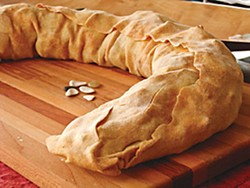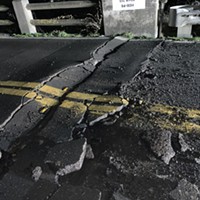[
{
"name": "Top Stories Video Pair",
"insertPoint": "7",
"component": "17087298",
"parentWrapperClass": "fdn-ads-inline-content-block",
"requiredCountToDisplay": "1"
}
]
From time to time, I bump into a memory kind of violently. For a while I am stunned not knowing what has hit me and from where. This rough awakening sometimes occurs with food memories, a possible side effect of my writing about edible things. When it happens, I try to make the memory come alive again. The results are always interesting.
I grew up in Umbria, an Italian region rich in culinary traditions like rocciata, a dessert that resembles strudel. The rocciata of my childhood came from the oven of a family friend who lives near Foligno. When the memory of it presented itself, I decided to turn it into something edible that would match what my taste buds remembered: pieces of apple, nuts, raisins and a thin layer of dough that, once baked, made a crisp envelope on the outside and soft partitions inside.
As the starting point of my memory revival I looked up the recipe on the web site of the Accademia Italiana della Cucina. I then experimented with different combinations of ingredients, looking for a pleasant balance. Variations on the basic theme of this traditional dish are numerous. I had my mother confirm with our friend that she uses an egg in the dough. She also adds to it some mistrà, an anise-flavored liqueur. I sprinkle anise seeds on the filling instead. Some of the variations include a richer filling than my version. I find that fewer ingredients can still provide a full gustatory experience. You are welcome to adjust the recipe that follows to please your palate.
Without further ado, here is my rendition: Bring 1/2 cup of water to lukewarm temperature. On a kneading board or other surface adapted to such use, combine 1 1/2 cups of unbleached white flour and 1/3 cup whole wheat pastry flour and make a well in the center. Push aside a tablespoon or so of the white flour for later use. Break one extra-large egg in the well and, with a fork, mix it with the surrounding flour until the mixture is no longer runny. Add a pinch of salt and 2 tablespoons of granulated sugar. Add in succession a total of 4 tablespoons of the water and 2 tablespoons of olive oil and mix with the flours and egg to form dough. As you knead the dough, add more water, another tablespoon or so. The dough should be soft, though not sticky. Use the flour you have set aside at the beginning, as needed, to keep your surface dusted to avoid sticking.
Shape the dough into a ball, cover it with a cloth, and let it rest in a cool, dry place for half an hour. In the meantime, peel and slice 1 lb and 3-4 oz. of apples (3 medium apples) and put the slices in a mixing bowl. Cut each apple into eighths, then cut each eighth into 1/8-1/4"-thick slices. Sprinkle a teaspoon of ground cinnamon and some grated lemon zest over the apple pieces, stir to distribute and set aside. Measure 3/4 cup of raisins in a small bowl, chopping them if they are large, and cover with warm water. I like to use half a cup of dark raisins and a quarter cup of golden ones. In another small bowl, measure two tablespoons of pine nuts and half a cup of walnuts chopped rather fine with a knife (see below how I treat walnuts before using them). Measure the walnuts after you chop them. If you don't have pine nuts, or you don't like them, use two additional tablespoons of chopped walnuts.
A short detour for walnuts: In her Vegetarian Cooking for Everyone (a beloved cookbook that is almost permanently stationed on my kitchen counter), Deborah Madison gives instructions on how to treat walnuts to improve their flavor and make them less irritating for people who are sensitive to the walnut skin. This pre-processing entails bringing a pan of water to the boil, adding the walnuts and letting them stand for a minute, then draining them and absorbing the excess moisture with a towel. The final step: spread the walnuts on a baking sheet and place them in the oven preheated to 300 F until they have dried out, 15-20 minutes. Remove them as soon as they are dry. If you decide to apply this treatment to your walnuts, you need to do it before starting with the recipe.
The dough for rocciata is then spread thin. With an eye towards the future, it is helpful, though not required, to spread it over a well-floured, creaseless cloth that can then be used for the final shaping. Warning: The cloth can become a nightmare if it is not floured enough, because in that case the dough will become tightly glued to it, with unpleasant consequences when detachment is attempted.
Roll the dough in a rectangle or whatever approximation of it you can achieve. Make sure the dough is thin but not so thin as to tear. I have learned from experience that I am geometrically challenged when it comes to rolling dough into some regular shape. Every time I use my rolling pin, I come up with a new shape that is not found in a geometry book. I am not trying to fight this strange creative streak, as long as the end result looks good.
Preheat the oven to 350 F and line a baking sheet with parchment paper. Drain the raisins. Distribute the apple pieces evenly over the dough, making a single layer and leaving some space between each piece and its neighbors. Separate the pieces that have become conjoined. Leave a 3/4" clear border around the perimeter. If you like the flavor of anise, sprinkle half a teaspoon of anise seeds. Scatter the pine nuts and walnuts, trying to achieve an even distribution, then do the same with the raisins.
At this point you are ready to roll up the dough, starting from one of the long sides. The cloth helps the rolling, but make sure you don't include it as a layer (it is not palatable, even after baking). Make a tight roll, but be gentle or the dough may tear. Press the flap and roll the two ends to seal them, wetting the dough slightly to make it sticky, if needed. The cloth may be helpful for the final transfer on the baking sheet. I shape my rocciata, which my husband calls "the sea cucumber," into a sort of horseshoe. It may be bent further, very gently, towards a spiral shape. Bake for 40 minutes: the surface will be golden, the two ends of a darker hue. When cool, cut it into slices and enjoy the way the concentric layers of ingredients play in your mouth.
How does my rendition of rocciata compare to what I ate as a child? As I expected the two are different, but I cannot eat my immaterial memory, while I have been savoring thick slices of the tangible result of my efforts, and so have the people with whom I have shared it. And that is good enough for me.
My Variation of the Rocciata Theme
Ingredients for the dough:
1 1/2 cups unbleached white flour
1/3 cup whole wheat pastry flour
1 extra-large egg
Pinch of salt
2 tablespoons granulated sugar (or more, to taste)
2 tablespoons olive oil
1/2 cup lukewarm water
Ingredients for filling:
1 lb and 3-4 oz peeled apples (3 medium apples) cut into eights and then into 1/8-1/4"-thick slices
1 teaspoon ground cinnamon
1/2 teaspoon grated lemon zest
1/2 teaspoon anise seeds (optional)
3/4 cup raisins
1/2 cup finely chopped walnuts
2 tablespoons pine nuts
Method:
DOUGH: On a kneading board or other surface, combine flours and make well in the center.
Push aside tablespoon of flour for later. Break egg in well and, with a fork, mix with surrounding flour.
Add salt and sugar, mix.
Add 4 tablespoons water and olive oil; mix with flour to form dough.
Add more water as you knead.
Dough should be soft, not sticky.
Use flour set aside to keep surface non-stick.
Shape dough into a ball, cover with cloth.
Let rest in cool, dry place for 1/2 hour.
FILLING: Cover raisins with warm water. Sprinkle apple slices with cinnamon and lemon zest, stir to distribute. Mix pine nuts and walnuts.
Roll dough into rectangle on well-floured, creaseless cloth. (Dough should be thin, without tears.)
Line baking sheet with parchment paper.
Drain raisins.
Distribute apple pieces evenly over the dough. (Leave 3/4" clear border around perimeter.)
Sprinkle anise seeds, if using.
Scatter nuts evenly, then raisins.
Roll up dough, tightly but without tearing.
Press flap and roll two ends to seal, wetting dough slightly to make it sticky, if needed.
Shape into horseshoe or spiral.
Bake for 40 minutes until golden.
Let cool, slice and enjoy.
Speaking of Food
more from the author
-
A Green Dish for Earth Day or Any Day
- Apr 18, 2024
-
Spreading Vegetable Joy
Beets for a colorful vegan starter
- Jan 18, 2024
-
A Daily Dose of Awe
- Jan 4, 2024
- More »



































